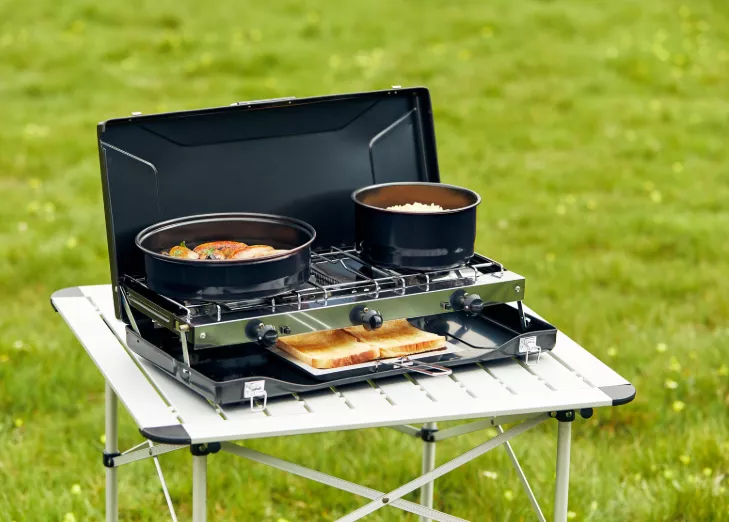Camping stoves make cooking outdoors simple and enjoyable. Whether you’re backpacking or car camping, the right stove can turn your trip into a delicious adventure.
What Is a Camping Stove?
A camping stove is a small, portable cooking appliance made for outdoor use. It lets you boil water, heat meals, and cook fresh food even in remote locations. Camping stoves run on various fuels and come in different sizes and styles.
Why You Need a Camping Stove
While campfires are fun, they are not always allowed or safe. A camping stove gives you a clean, fast, and reliable way to cook outdoors. It is especially helpful during cold or rainy conditions.
Main Types of Camping Stoves
1. Canister Stoves
These use pre-filled fuel canisters. They are small, light, and easy to use. Many backpackers prefer them for their simplicity. Screw the stove onto the canister, light it, and you’re ready to cook.
2. Liquid Fuel Stoves
These stoves use white gas or other liquid fuels. They perform well in cold temperatures and at high altitudes. They need regular maintenance and can be heavier than canister stoves.
3. Wood-Burning Stoves
These stoves burn small twigs or wood pieces. They are eco-friendly since you don’t need to carry fuel. However, they depend on dry wood, which is not always available.
4. Solid Fuel Stoves
These stoves use fuel tablets. They are ultra-light and simple, but they cook slowly and leave residue. Good for emergencies or short solo trips.
5. Multi-Fuel Stoves
These versatile stoves can use both canister and liquid fuels. They are great for long expeditions and international travel. However, they tend to be more expensive and need more care.
How to Choose the Right Camping Stove
1. Trip Type
If you’re going fun camping with family or friends, a larger stove with multiple burners is great. For backpacking, choose a lightweight stove that fits in your pack.
2. Fuel Availability
Pick a stove with fuel that is easy to find. Canister fuel is widely available, but white gas or other fuels may be better in cold places.
3. Cooking Needs
Think about what you’ll cook. If you’re just boiling water, a simple stove works. If you want to fry or simmer, choose one with flame control.
4. Weather and Altitude
In cold or high places, liquid fuel stoves work better. Canister stoves may lose pressure in freezing temperatures.
5. Group Size
Bigger groups need stoves with more power and larger pots. Solo campers can go with minimalist setups.
Important Features to Look For
1. Boil Time
Faster boil time means less waiting and less fuel used. Check product specs to compare boil times.
2. Weight and Size
For hiking, choose light and compact stoves. For car camping, weight is less important.
3. Flame Control
Good flame control lets you simmer, sauté, and avoid burning food. This is important for gourmet outdoor cooks.
4. Wind Protection
Some stoves come with built-in wind shields. Wind can make cooking slow and uneven.
5. Ignition System
Piezo ignition systems make lighting the stove easy without matches or lighters. Still, always carry backup matches.
How to Use a Camping Stove Safely
1. Choose a Flat Surface
Set your stove on level ground to prevent tipping. Avoid placing it on dry grass or flammable surfaces.
2. Keep Fuel Away from Flames
Store fuel bottles and canisters away from the cooking area. Never refill a hot stove.
3. Ventilation Is Key
Never use a stove inside a tent or car. It can cause carbon monoxide buildup and fire risk.
4. Watch the Weather
Strong wind and rain can affect stove performance. Use a windscreen if needed and cook in sheltered areas.
5. Clean and Maintain Your Stove
Clean your stove after each trip. For liquid fuel stoves, clean the fuel lines and check for leaks.
Tips for Cooking on a Camping Stove
1. Prepare Ingredients at Home
Cut vegetables, measure spices, and pack food in containers before your trip. This saves time and mess outdoors.
2. Bring the Right Cookware
Use lightweight, heat-resistant pots and pans. Avoid glass and thin metal cookware.
3. Plan Simple Meals
One-pot meals, soups, and pasta are easy to cook and clean. Try recipes in your camping guide before your trip.
4. Use Lids
Lids help food cook faster and save fuel. Always pack lids for your pots.
5. Don’t Forget Cleanup
Bring biodegradable soap, a small sponge, and trash bags. Clean up food waste to avoid attracting animals.
Recommended Accessories
1. Fuel Canisters or Bottles
Always carry extra fuel. Estimate how much you’ll use and bring a little more.
2. Windscreen
A windscreen helps your stove perform better in breezy conditions.
3. Stove Stand
Some stoves can be top-heavy. A stand improves stability, especially on uneven ground.
4. Lightweight Cookset
A good cookset includes pots, pans, and utensils. Choose one that nests together for easy packing.
5. Lighter and Matches
Even if your stove has built-in ignition, always bring backups.
Final Thoughts
A camping stove is a valuable tool for any outdoor trip. Whether you’re a solo adventurer or part of a large group, the right stove helps you cook safe and tasty meals. Consider fuel type, weather, and group size when choosing. Don’t forget safety and practice using your stove before heading out.
When you’re ready to enjoy meals under the stars, take your stove, pack some recipes, and enjoy the magic of fun camping.
Related topics
- No Fridge Camping: What Foods Can You Bring?
- How to Hang a Travel Hammock: The Ultimate Guide
- What Do You Do When Camping?

